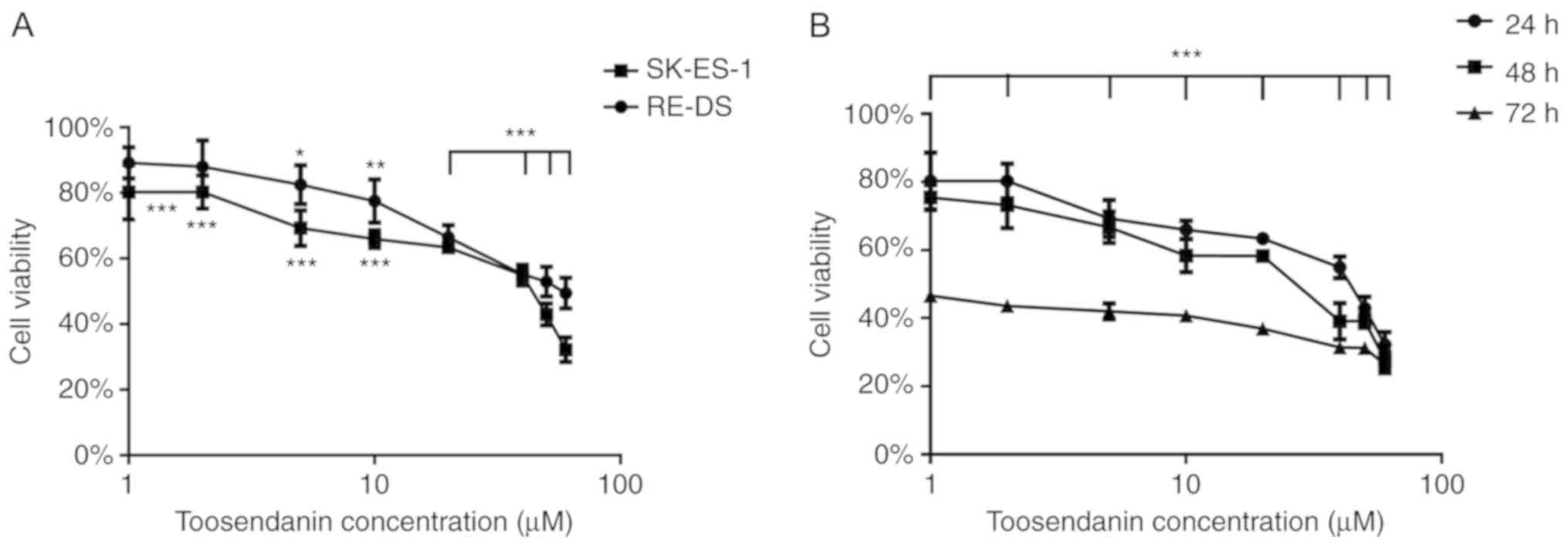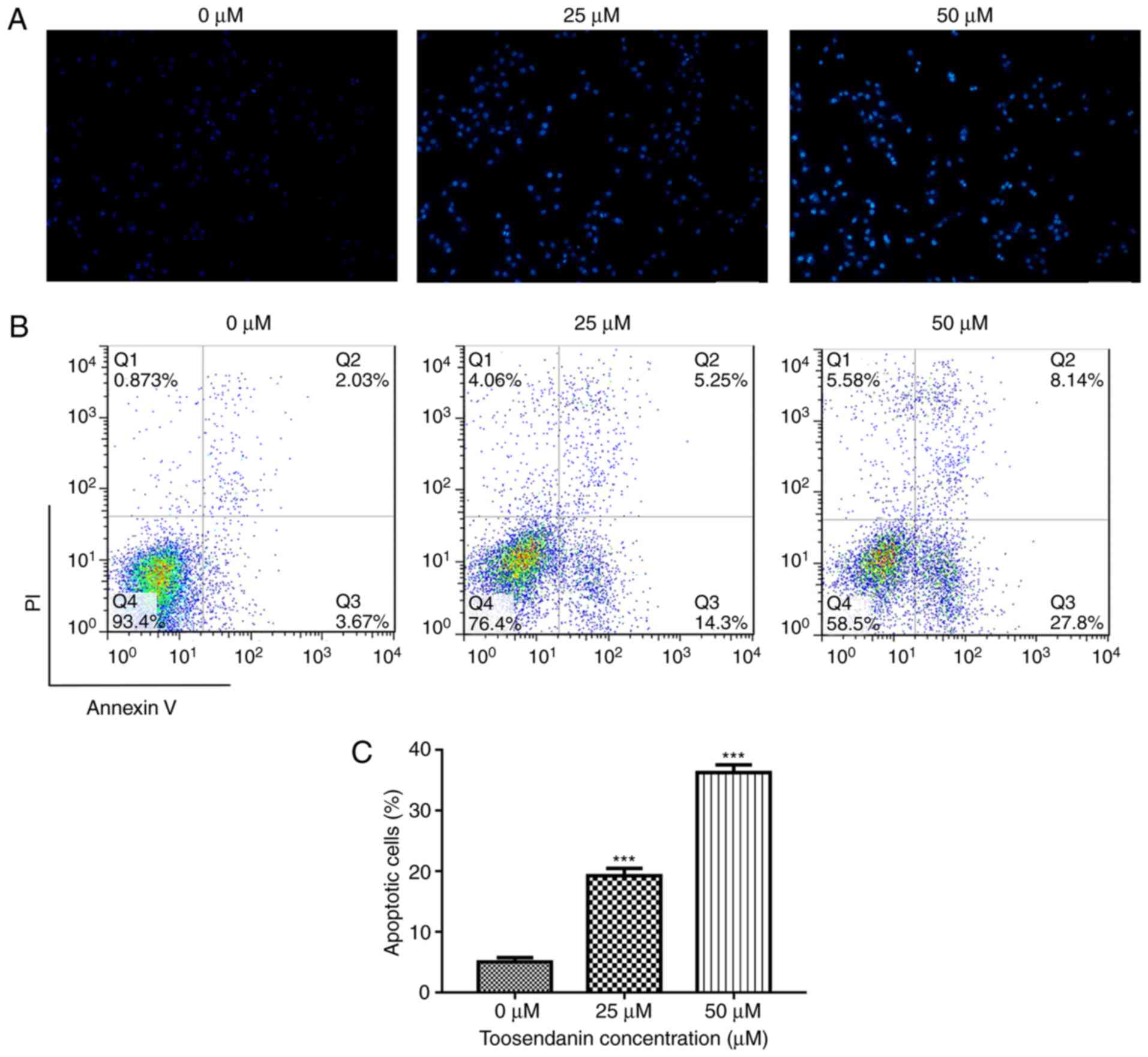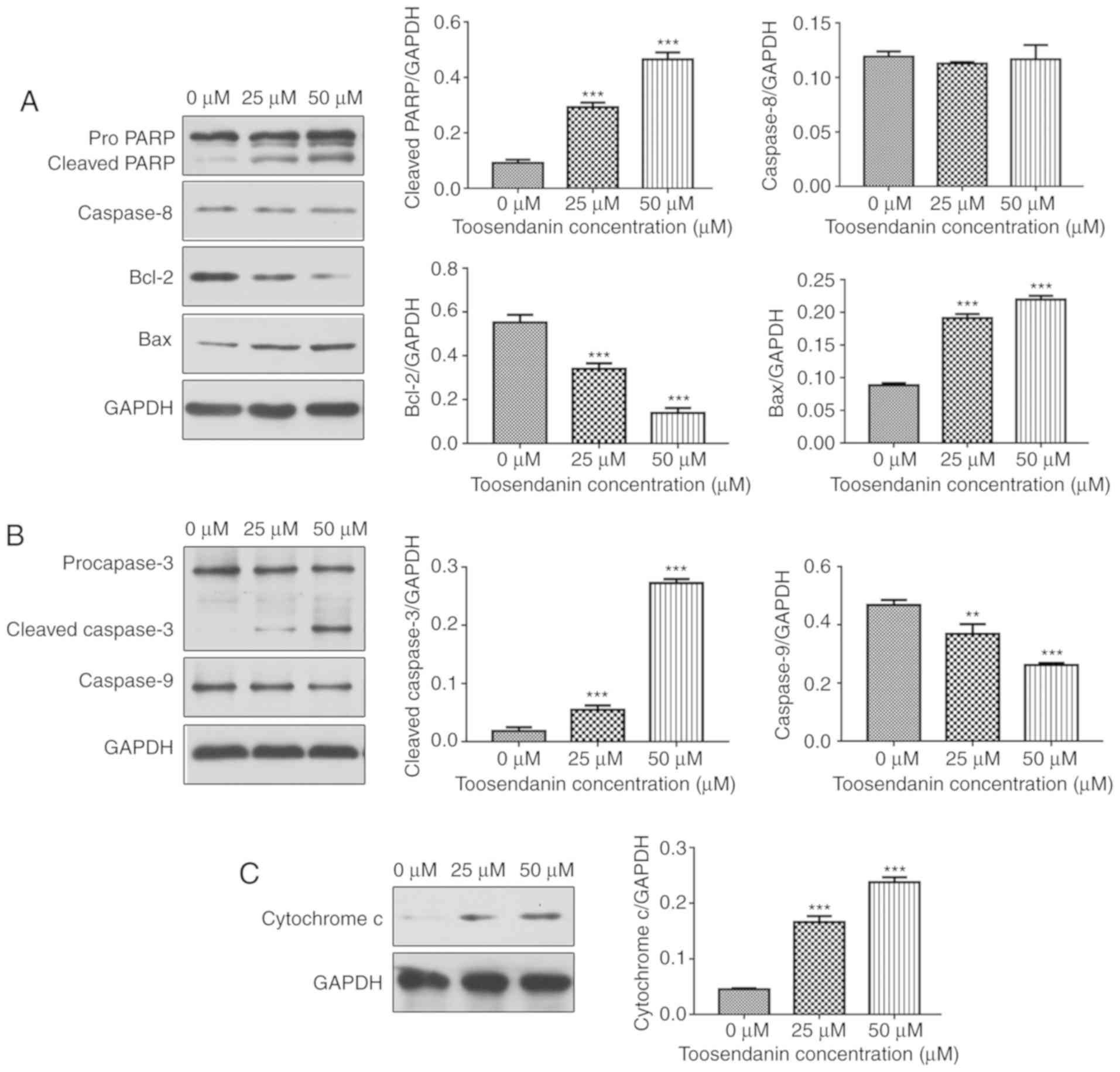|
1
|
Ahmed S, Anuntiyo J, Malemud CJ and Haqqi
TM: Biological basis for the use of botanicals in osteoarthritis
and rheumatoid arthritis: A review. Evid Based Complement Alternat
Med. 2:301–308. 2005. View Article : Google Scholar : PubMed/NCBI
|
|
2
|
Zhang K, Wang X, Wang C, Zheng H, Li T,
Xiao S, Wang M, Fei C, Zhang L and Xue F: Investigation of
quinocetone-induced mitochondrial damage and apoptosis in HepG2
cells and compared with its metabolites. Environ Toxicol Pharmacol.
39:555–567. 2015. View Article : Google Scholar : PubMed/NCBI
|
|
3
|
Zhang J, Song J, Wu D, Wang J and Dong W:
Hesperetin induces the apoptosis of hepatocellular carcinoma cells
via mitochondrial pathway mediated by the increased intracellular
reactive oxygen species, ATP and calcium. Med Oncol. 32:1012015.
View Article : Google Scholar : PubMed/NCBI
|
|
4
|
Pieme CA, Santosh GK, Tekwu EM, Askun T,
Aydeniz H, Ngogang JY, Bhushan S and Saxena AK: Fruits and barks
extracts of Zanthozyllum heitzii a spice from Cameroon induce
mitochondrial dependent apoptosis and G0/G1 phase arrest in human
leukemia HL-60 cells. Biol Res. 47:542014. View Article : Google Scholar : PubMed/NCBI
|
|
5
|
Zhou Q, Wu X, Wen C, Wang H, Wang H, Liu H
and Peng J: Toosendanin induces caspase-dependent apoptosis through
the p38 MAPK pathway in human gastric cancer cells. Biochem Biophys
Res Commun. 505:261–266. 2018. View Article : Google Scholar : PubMed/NCBI
|
|
6
|
Shi YL and Li MF: Biological effects of
toosendanin, a triterpenoid extracted from Chinese traditional
medicine. Prog Neurobiol. 82:1–10. 2007. View Article : Google Scholar : PubMed/NCBI
|
|
7
|
Pei Z, Fu W and Wang G: A natural product
toosendanin inhibits epithelial-mesenchymal transition and tumor
growth in pancreatic cancer via deactivating Akt/mTOR signaling.
Biochem Biophys Res Commun. 493:455–460. 2017. View Article : Google Scholar : PubMed/NCBI
|
|
8
|
Zhang T, Li J, Yin F, Lin B, Wang Z, Xu J,
Wang H, Zuo D, Wang G, Hua Y and Cai Z: Toosendanin demonstrates
promising antitumor efficacy in osteosarcoma by targeting STAT3.
Oncogene. 36:6627–6639. 2017. View Article : Google Scholar : PubMed/NCBI
|
|
9
|
Windsor R, Strauss S, Seddon B and Whelan
J: Experimental therapies in Ewing's sarcoma. Expert Opin Investig
Drugs. 18:143–159. 2009. View Article : Google Scholar : PubMed/NCBI
|
|
10
|
Teicher BA, Bagley RG, Rouleau C, Kruger
A, Ren Y and Kurtzberg L: Characteristics of human Ewing/PNET
sarcoma models. Ann Saudi Med. 31:174–182. 2011. View Article : Google Scholar : PubMed/NCBI
|
|
11
|
Zhang Z, Huang L, Yu Z, Chen X, Yang D,
Zhan P, Dai M, Huang S, Han Z and Cao K: Let-7a functions as a
tumor suppressor in Ewing's sarcoma cell lines partly by targeting
cyclin-dependent kinase 6. DNA Cell Biol. 33:136–147. 2014.
View Article : Google Scholar : PubMed/NCBI
|
|
12
|
Ross KA, Smyth NA, Murawski CD and Kennedy
JG: The biology of ewing sarcoma. ISRN Oncol.
2013:7597252013.PubMed/NCBI
|
|
13
|
Scotlandi K: Targeted therapies in Ewing's
sarcoma. Adv Exp Med Biol. 587:13–22. 2006. View Article : Google Scholar : PubMed/NCBI
|
|
14
|
Ye C, Yu X, Zeng J, Dai M and Zhang B:
Effects of baicalein on proliferation, apoptosis, migration and
invasion of Ewing's sarcoma cells. Int J Oncol. 51:1785–1792. 2017.
View Article : Google Scholar : PubMed/NCBI
|
|
15
|
Cohen GM: Caspases: The executioners of
apoptosis. Biochem J. 326:1–16. 1997. View Article : Google Scholar : PubMed/NCBI
|
|
16
|
Singhal S, Vachani A, Antin-Ozerkis D,
Kaiser LR and Albelda SM: Prognostic implications of cell cycle,
apoptosis, and angiogenesis biomarkers in non-small cell lung
cancer: A review. Clin Cancer Res. 11:3974–3986. 2005. View Article : Google Scholar : PubMed/NCBI
|
|
17
|
Viktorsson K, Lewensohn R and Zhivotovsky
B: Apoptotic pathways and therapy resistance in human malignancies.
Adv Cancer Res. 94:1432005. View Article : Google Scholar : PubMed/NCBI
|
|
18
|
Tada K, Takido M and Kitanaka S: Limonoids
from fruit of Melia toosendan and their cytotoxic activity.
Phytochemistry. 51:787–791. 1999. View Article : Google Scholar : PubMed/NCBI
|
|
19
|
Zhang B, Wang ZF, Tang MZ and Shi YL:
Growth inhibition and apoptosis-induced effect on human cancer
cells of toosendanin, a triterpenoid derivative from chinese
traditional medicine. Invest New Drugs. 23:547–553. 2005.
View Article : Google Scholar : PubMed/NCBI
|
|
20
|
He Y, Wang J, Liu X, Zhang L, Yi G, Li C,
He X, Wang P and Jiang H: Toosendanin inhibits hepatocellular
carcinoma cells by inducing mitochondria-dependent apoptosis.
Planta Med. 76:1447–1453. 2010. View Article : Google Scholar : PubMed/NCBI
|
|
21
|
Ju J, Qi Z, Cai X, Cao P, Liu N, Wang S
and Chen Y: Toosendanin induces apoptosis through suppression of
JNK signaling pathway in HL-60 cells. Toxicol In Vitro. 27:232–238.
2013. View Article : Google Scholar : PubMed/NCBI
|
|
22
|
Wang X: The expanding role of mitochondria
in apoptosis. Genes Dev. 15:2922–2933. 2001.PubMed/NCBI
|
|
23
|
Wang C and Youle RJ: The role of
mitochondria in apoptosis*. Annu Rev Genet. 43:95–118. 2009.
View Article : Google Scholar : PubMed/NCBI
|
|
24
|
Lu X, Ji C, Tong W, Lian X, Wu Y, Fan X
and Gao Y: Integrated analysis of microRNA and mRNA expression
profiles highlights the complex and dynamic behavior of
toosendanin-induced liver injury in mice. Sci Rep. 6:342252016.
View Article : Google Scholar : PubMed/NCBI
|












